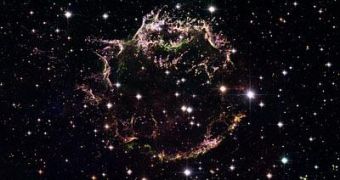The Hubble Space Telescope has obtained a detailed look of the remains of a supernova explosion known as Cassiopeia A (Cas A). This is the youngest known remnant from a supernova explosion in the Milky Way. Astronomers estimate that Cas A is only about 340 years old.
The image is a composite made from 18 separate images taken using Hubble's Advanced Camera for Surveys (ACS). The image shows a broken ring of bright filamentary and clumpy stellar ejecta, revealing the complex and intricate structure of the star's shattered fragments.
The Shockwave from the supernova blast caused the debris to glow. This glow allows the astronomers to determine the chemical composition of various gases forming the huge swirls. Oxygen causes the bright green filaments, sulfur the red and purple ones and hydrogen and nitrogen the blue ones.
A supernova is the end result of the collapse of a massive star - when the star finishes its hydrogen "fuel" it collapses under its own weight and eventually explodes. This explosion blows the outer layers of the star and it is so powerful that it lights the sky brighter than an entire galaxy. Supernova explosions produce the elements beyond oxygen fusing together simpler elements. The production of such elements needs the extreme conditions found during a supernova explosion.
Astronomers are using Hubble to observe the changes in the rapidly expanding filaments. The expansion is so fast that changes can be seen even at intervals of only a few months. Considering the distance between us and Cas A (ten thousand light-years away from Earth) and using the differences between two images taken 9 months apart, scientists have computed that a faint stream of debris seen along the upper left side of the remnant is moving with up to 50 million kilometers per hour. At this speed, one would travel from Earth to the Moon in 30 seconds!

 14 DAY TRIAL //
14 DAY TRIAL //